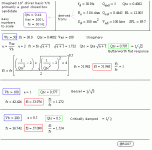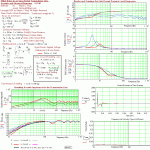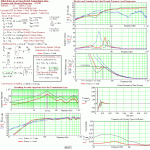hi,
I'm thinking about trying out an classic tl based on the alignments from mjk. in this context i have some questions, maybe some of you are able to help out:
1. I found nothing on cone excursion in tl's. is it like br with a lower excursion around tuning freq? the question is important cause the driver has a somewhat limited x-max (3,5mm). a rising cone xcursion below 40-45Hz wouldn't be a problem cause i'll use a digital xover and a highpass/subsonic-filter
2. I read somewhere it's recommended to set the tuning freq around fs. my driver has a fs=48hz. MJK-Classic alignments use 5Hz-steps. What should be preferred 45 or 50Hz? And which is better for a lower cone excursion?
3. I'll think to try out a tapered line cause the graph's from mjk - based on the ripple - look promising. But there are 4 possibilities: 0,5/0,33/0,2/0,1 SL/SO-Ratio. Any recommendations on these?
thank's for your comments and help in advance
galac
p.s. driver spec's qts=0,31 Sd=96cm2 re=5,7
I'm thinking about trying out an classic tl based on the alignments from mjk. in this context i have some questions, maybe some of you are able to help out:
1. I found nothing on cone excursion in tl's. is it like br with a lower excursion around tuning freq? the question is important cause the driver has a somewhat limited x-max (3,5mm). a rising cone xcursion below 40-45Hz wouldn't be a problem cause i'll use a digital xover and a highpass/subsonic-filter
2. I read somewhere it's recommended to set the tuning freq around fs. my driver has a fs=48hz. MJK-Classic alignments use 5Hz-steps. What should be preferred 45 or 50Hz? And which is better for a lower cone excursion?
3. I'll think to try out a tapered line cause the graph's from mjk - based on the ripple - look promising. But there are 4 possibilities: 0,5/0,33/0,2/0,1 SL/SO-Ratio. Any recommendations on these?
thank's for your comments and help in advance
galac
p.s. driver spec's qts=0,31 Sd=96cm2 re=5,7
Hi, I find it difficult to answer your question as you have to be more specific using your unknown driver, some unknown parameters are missing.
Submitting a helping not yet posted text I wrote more than a year ago.
Quote myself:
Quote/
…A few words dedicated for those of you who want forum member help when bringing a proposed unidentified driver with very few known T/S parameters in order to fulfil a your DIY-dream speaker, when in additional to this first posting are asking for simulation help of this driver together with a lot of detailed questions along with requesting (suggesting) performance out of this world in an acoustical specific rather complicated enclosure (complicated (damped) air volume) with a lot of prerequisite physical detailed requirements.
Read this first unless you want to be attacked with diverging and desultory proposals, leading you immediate away from your first intentions:
Minimum number of parameters needed to estimate a suitable volume for an enclosure only or making it possible to show a plotted graph of an FR of a HP (high pass) transfer function for a driver based on T/S-parameters are fs, Vas, and Qts, this for basic enclosures like closed and boxes using the rear radiation of the driver cone.
The most basic freebie simulations covers the use of these parameters, as a graph can be plotted and will show no more than a plotted 0 dB referenced FR curve. more…
If the driver sensitivity is known in dB SPL, the graph can be scaled for different power inputs.
If RMS or peak power handling in Watts is included, maximum achievable pass band SPL can be estimated roughly at a certain distance from the speaker.
If x-max and Sd also is given plots can be executed for different power inputs showing power handling/excursion at any chosen frequency and generation of other curves common to most available freebie programs.
Extending the use of T/S to include detailed air volume performance using simulation program(s) showing quarter-wave behaviour, I find MJK:s the most intuitive:
When using MJK: s sheets where the air volume damping based on geometry and stuffing materials, a few more parameters is necessary to be included in additional to the above mentioned.
That is ideal Re, Qes, Qms, BL, Sd, and Le (+ knowing x-max and a usable Input Power level).
Le can be left out, as it mostly doesn’t affect the low-end slope on the FR HP transfer function.
X-max can be left out but then it is up to the user of MJK: s program to be aware of the consequences when Input power is scaled, i.e. changing the default value from the nominal 1 W.
As seen the driver Qts is not necessary, it is derived from Qes and Qms, so if Qts is known only one of Qes or Qms in mandatory.
BL can be left out only if fs, Re, Sd, Qms, Qes and Vas are given.
Then it’s up to the user to calculate BL factor using MJK: s consistency program sheet and if Vas is left out knowing Re, Sd, Qms, Qes and BL is mandatory.
If Re or Sd is left out, all other mentioned parameters must be given.
So the minimum parameters for using MJK: s sheets are:
Best: fs, Vas, Sd, Qes, Qms +Re, BL...
fs, Vas, Sd, Qts,(Qes or Qms) +Re, BL...
fs, Sd, Qes, Qms, +Re +BL_(Vas left out)...
fs, Vas, Qes, Qms, +Re, BL_(Sd left out)...
fs, Vas, Sd, Qes, Qms +BL_(Re left out)...
fs, Vas, Sd, Qes, Qms, +Re_(BL left out)…
…/End Quote.
Excuse me, if I have left out any other valid combination.
b
Submitting a helping not yet posted text I wrote more than a year ago.
Quote myself:
Quote/
…A few words dedicated for those of you who want forum member help when bringing a proposed unidentified driver with very few known T/S parameters in order to fulfil a your DIY-dream speaker, when in additional to this first posting are asking for simulation help of this driver together with a lot of detailed questions along with requesting (suggesting) performance out of this world in an acoustical specific rather complicated enclosure (complicated (damped) air volume) with a lot of prerequisite physical detailed requirements.
Read this first unless you want to be attacked with diverging and desultory proposals, leading you immediate away from your first intentions:
Minimum number of parameters needed to estimate a suitable volume for an enclosure only or making it possible to show a plotted graph of an FR of a HP (high pass) transfer function for a driver based on T/S-parameters are fs, Vas, and Qts, this for basic enclosures like closed and boxes using the rear radiation of the driver cone.
The most basic freebie simulations covers the use of these parameters, as a graph can be plotted and will show no more than a plotted 0 dB referenced FR curve. more…
If the driver sensitivity is known in dB SPL, the graph can be scaled for different power inputs.
If RMS or peak power handling in Watts is included, maximum achievable pass band SPL can be estimated roughly at a certain distance from the speaker.
If x-max and Sd also is given plots can be executed for different power inputs showing power handling/excursion at any chosen frequency and generation of other curves common to most available freebie programs.
Extending the use of T/S to include detailed air volume performance using simulation program(s) showing quarter-wave behaviour, I find MJK:s the most intuitive:
When using MJK: s sheets where the air volume damping based on geometry and stuffing materials, a few more parameters is necessary to be included in additional to the above mentioned.
That is ideal Re, Qes, Qms, BL, Sd, and Le (+ knowing x-max and a usable Input Power level).
Le can be left out, as it mostly doesn’t affect the low-end slope on the FR HP transfer function.
X-max can be left out but then it is up to the user of MJK: s program to be aware of the consequences when Input power is scaled, i.e. changing the default value from the nominal 1 W.
As seen the driver Qts is not necessary, it is derived from Qes and Qms, so if Qts is known only one of Qes or Qms in mandatory.
BL can be left out only if fs, Re, Sd, Qms, Qes and Vas are given.
Then it’s up to the user to calculate BL factor using MJK: s consistency program sheet and if Vas is left out knowing Re, Sd, Qms, Qes and BL is mandatory.
If Re or Sd is left out, all other mentioned parameters must be given.
So the minimum parameters for using MJK: s sheets are:
Best: fs, Vas, Sd, Qes, Qms +Re, BL...
fs, Vas, Sd, Qts,(Qes or Qms) +Re, BL...
fs, Sd, Qes, Qms, +Re +BL_(Vas left out)...
fs, Vas, Qes, Qms, +Re, BL_(Sd left out)...
fs, Vas, Sd, Qes, Qms +BL_(Re left out)...
fs, Vas, Sd, Qes, Qms, +Re_(BL left out)…
…/End Quote.
Excuse me, if I have left out any other valid combination.
b
galac said:
1. I found nothing on cone excursion in tl's. is it like br with a lower excursion around tuning freq?
2. I read somewhere it's recommended to set the tuning freq around fs. my driver has a fs=48hz. MJK-Classic alignments use 5Hz-steps. What should be preferred 45 or 50Hz? And which is better for a lower cone excursion?
3. I'll think to try out a tapered line cause the graph's from mjk - based on the ripple - look promising. But there are 4 possibilities: 0,5/0,33/0,2/0,1 SL/SO-Ratio. Any recommendations on these?
Greets!
1) Yes, though how much depends on the pipe loading and amount of stuffing. As a general rule, don't expect any more power handling than a BR.
2) Yes, that's the classical alignment. Well, in theory you'd calculate the actual specs based on his charts, but using the higher of the two is fine.
3) FWIW, my rule-of-thumb (ROT):
Qts = ~0.4, use a straight taper
Qts = < ~0.4, use a TQWT (reverse taper) with taper ratio increasing with decreasting Qts
Qts = > ~0.4 use a horn (positive taper) with flare increasing with increasing Qts
I used horn theory to choose the actual expansion and tweaked it as required, but with MJK's WS you can dial it in to suit with just stuffing density left to experiment.
GM
bjorno said:
Submitting a helping not yet posted text I wrote more than a year ago.
Greets!
Looks good, I've started several of these and never got around to finishing any of them. Now I've got one to point to, thanks!
GM
…Now I've got one to point to,thanks!…
Thank you Gm, You pretty much summed up the starting point to choose a Qts number suitable to generate a simple traditional TL and how to reason if the driver Qts is lower or higher.
I’m still using (since about 30 years) a very similar, easy to remember, slightly expanded ‘Rot’ to pick a driver with preferred T/S numbers.
My basic T/S driver specification for a suitable TL -driver was and are a driver very suitable for a closed box having lowest f- 3dB when picking a flat BW Qtc= 0.7 alignment in a box with Vas/2 volume.
In case for the traditional TL case I mostly have used (and still use) a tapered or in case non-taper volume >= the Vas value, trying to avoid volumes > 2 x Vas as then x-max turns out to be very most limiting factor for bass extension/acoustic power.
So, if the driver Qts number is chosen to 0.41 then the Vas number if divided by 2 results in the mentioned closed box volume suitable for a flat BW response (f-3dB optimised) and if multiplied by 2 in to a critically damped box were Q= 0.5 and last, if kept as is, a Qtc = 0.58 = Bessel response, also easy to remember.
See picture # 1(3) where a imaginary driver T/S numbers are shown for a couple of closed box calculations and picture 2(3) where the driver also can be compared when used in a straight TL or in a traditional 3:1 tapered Tl where also the easy remembered numbers are in use (Look at the resulting TL volumes).
galac, See picture 3(3) where your driver is simulated.
b
1(3)
Attachments
@GM
thank you for your explanations and advice!
@bjorno
special thanks for the simulations. These cleared up my questions completly. It's interessing that - as GM stated - the cone excusion of a TL is very comparable to BR. in fact i hoped for a bit more powerhandling.
greetings
thank you for your explanations and advice!
@bjorno
special thanks for the simulations. These cleared up my questions completly. It's interessing that - as GM stated - the cone excusion of a TL is very comparable to BR. in fact i hoped for a bit more powerhandling.
greetings
- Status
- This old topic is closed. If you want to reopen this topic, contact a moderator using the "Report Post" button.
- Home
- Loudspeakers
- Multi-Way
- need some classic tl advice


